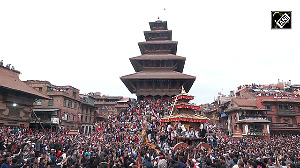Kinley moved it off the No.1 slot a couple of years ago, but Bisleri's brand recall is eyebrow-raising -- the 38-year-old brand is still generic to bottled water in India, which is worth Rs 1,000-1,200 crore (Rs 10-12billion).
And that is in spite of the more than 1,200 bottled water factories and 100 brands scampering for their share of the Rs 1,800-crore (Rs 18 billion) bottled water market (Source: Technopak Advisors).
Still, 100 competitors means you can't sit back and relax, even if the market is surging ahead at 40 per cent a year; you need to keep up the buzz around your brand. Which is why in October last year, Parle Bisleri changed the look and feel of its flagship product, introduced a new variant (natural mountain water) and announced its plans to launch the
brand in the US -- a huge market for designer waters.
Bisleri has ambitious plans to invest Rs 220 crore (Rs 2.2 billion) in its new variant, manufacturing planets and distribution: it will invest Rs 100 crore (Rs 1 billion) -- funded through internal accruals -- in the natural mountain water business, including Rs 40 crore (Rs 40 million) for two plants in Uttaranchal and Himachal Pradesh, and Rs 60 crore (Rs
600 million) for infrastructure development -- increasing the existing manufacturing facility as well as widening the distribution network.
Over the next two years, the company will also spend more than Rs 60 crore (Rs 600 million) on aggressive marketing. It also plans to launch branded ice and flavoured and vitamin-enriched water. But, laughs Parle Bisleri chairman Ramesh Chauhan, "Those may have to wait. I am still overwhelmed by the current changes."
To be sure, the changes are noteworthy. For decades now, Bisleri has been sold in conical bottles -- a legacy from the 1960s when the water was sold in glass beer bottles. Although it switched to PET in the 1980s, the shape didn't change.
Instead, the company just added some more shapes: conical one-litre bottles, hexagonal half-litre ones and rectangular two-litre bottles.
"We were just bumbling along," admits Chauhan. Now, both regular bottled water and the mountain water variant are sold in a streamlined, round shape, while the ubiquitous blue of the logo has given way to a more international looking aqua green.
"It takes courage for a generic brand like Bisleri to make such a major change," says Ashok Kurien, CMD, Ambience Publicis Advertising, the agency that has been associated with Parle Bisleri for over 20 years.
The colour of money
Chauhan claims the changes are already bearing results -- apparently, sales are up 50 per cent on a month-on-month basis. Equally importantly, the packaging changes have helped Parle Bisleri shave costs.
Earlier, fixing labels on differently shaped bottles -- especially the ones that are tapered at the neck -- was difficult and time consuming. Labelling round bottles has increased the speed 10 times.
Eight months ago, the company also launched the prototype of a rounded bottle with slightly wider necks ("Alaska neck", in industry terminology). The change in design meant using 2-3 grams less of plastic in every bottle, which added up to an annual saving of Rs 3 crore (Rs 30 million).
Even the new label helped the company cut costs -- by up to Rs 6 crore (Rs 60 million) a year. The earlier shrink label has been replaced with one made of superior biaxially-oriented polypropylene film that can not only take more colours, but costs half of shrink labels.
Now Chauhan is hoping the new bottle design will help improve the output as well. "Earlier, the quality of the bottles wasn't consistent - some were thicker than others, some were bent around the bottom and so on. All this hampered our efforts to increase productivity," he says.
With a uniform design for all product sizes, the company aims to double bottling capacity in its 23 plants, to 200 million cases a day, by the first half of 2007.
Market buzz
By and large, most brand analysts approve of Bisleri's attempt to reinvent itself.
Says Harish Bijoor, CEO, Harish Bijoor Consult Inc, "The aqua green is representative of freshness and health, two qualities you associate with water."
The changed colour scheme also helps the brand stand out in a sea of almost-uniformly blue-toned bottles of water, the colour that was brought into India by Bisleri. Aqua green connects with the images of water, agrees A G Krishnamurthy, chairman, AGK Brand Consulting, and former chairman and MD of Mudra.
The extension into mountain water, though, has taken some market watchers by surprise, especially since it carries the same brandname (which is virtually synonymous in India with plain bottled water).
"I did not expect them to use the same name since Bisleri is generic to packaged water," emphasises Arvind Singhal, chairman, Technopak Advisors.
He adds that while building a new brand from scratch would have meant huge costs for the company (perhaps up to half the present turnover of the company), the opportunity it afforded would have been worth the investment.
There's another potential problem with the new launch: it looks the same as the regular version, has the same brandname, and is just another type of water -- but costs Rs 8 more. Isn't there a risk in that strategy of confusing customers who may think their retailer is trying to rip them off?
"Look at the label closely before you jump to conclusions," warns Kurien. Well, the mountain water bottles do show a mountain in the green label background and also clearly state what kind of water it is, with the cap bearing the same image.
Kurien adds that even the crates for the new variant look different because of the clear image of mountains on them. "We tried to create a family colour for all Bisleri brands as well as make the difference clear," he defends.
Chauhan, too, feels that people demanding mountain water are a select few, who will know what they are buying. Natural mineral water is a very niche category at present, accounting for just 2-5 per cent of the packaged water industry.
Still, Bisleri will have to deal with entrenched competition - Himalaya and Catch have been present in this category for some time now. And Bisleri is prepared for a battle.
In November, it kicked off a high-decibel print, outdoor and television campaign, anchored by Ambience. The company has been targeting malls, multiplexes, five-star hotels and premium restaurants to stock the variant, in a bid to reach out to its target customer -- affluent, urban and health conscious.
It will probably do well, predicts Bijoor. "We are entering a generation that is more concerned about health and wellness than ever before," he points out.
Chauhan is equally optimistic about the success of his new ventures. He is counting on natural water sales crossing Rs 200 crore (Rs 2 billion) in the next two years.
Meanwhile, the market is buzzing with talks that the action surrounding Bisleri is a "dress-up" to impress potential buyers for the brand -- speculation has extended to the level that the brand has been valued at close to Rs 150 crore (Rs 1.5 billion).
For his part, Chauhan dismisses the sale theory as "rubbish". Whether it is true or not, there's no denying that Bisleri is sailing in different waters now.







 © 2025
© 2025